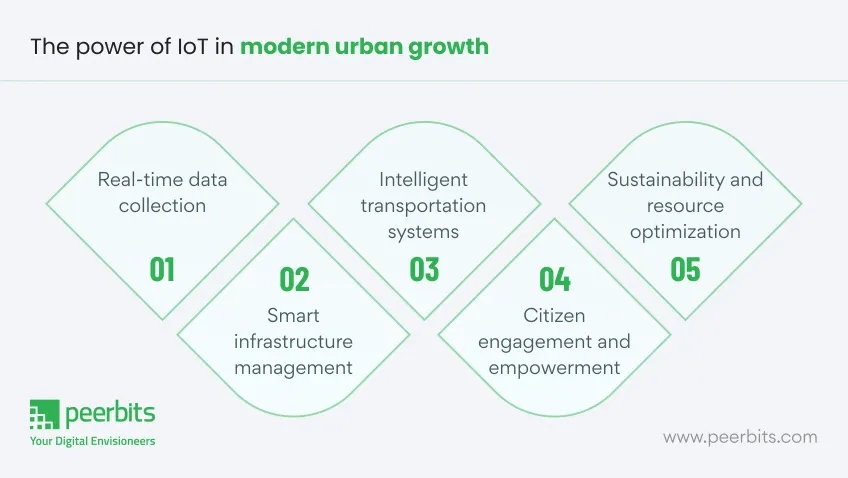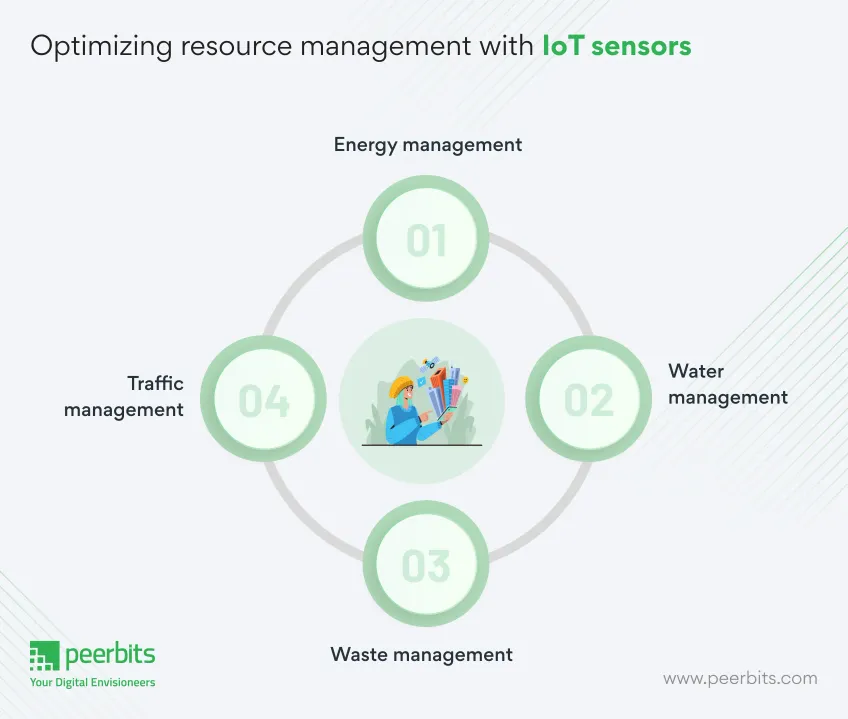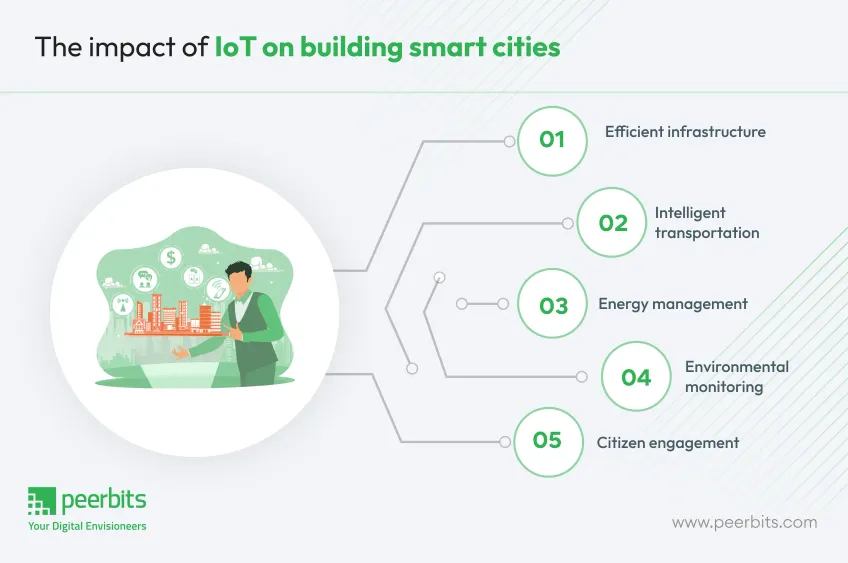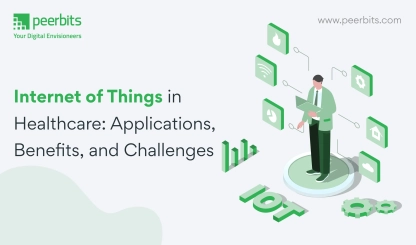The concept of smart cities has gained significant traction in recent years as urban areas face growing challenges related to population growth, resource management, and infrastructure demands.
In this age of connectivity and technological advancement, the Internet of Things (IoT) has emerged as a powerful catalyst for driving urban development and transforming cities into intelligent, sustainable, and efficient ecosystems.
IoT for smart cities plays a central role in creating IoT Smart city infrastructure, improving daily urban functions, and addressing key urban challenges.
This blog will explore how IoT is revolutionizing urban development and shaping the future of smart cities and IoT.
What are smart cities?
Smart cities are urban environments that use technology and data to improve the quality of life for their residents, promote sustainability, optimize resource consumption, and IoT for smart cities enhances city operations.
Smart cities collect and analyze data from various sources to make informed decisions and deliver improved services by integrating IoT devices and networks.
As urban areas face increasing challenges related to population growth, resource management, and sustainable development, the concept of smart cities has emerged as a transformative solution.
Smart cities use technology and data to create intelligent, connected, and sustainable urban ecosystems. Among the various technologies driving this urban revolution, the Internet of Things for smart cities plays an important role in the future.
Importance of smart cities
The importance of smart cities lies in their potential to tackle various urban challenges. With the majority of the world's population residing in cities, smart city initiatives have become critical for creating livable, sustainable, and inclusive urban spaces.
Integrating technology and data-driven solutions, smart cities aim to:
1. Enhance efficiency
Smart cities optimize the use of resources such as energy, water, and transportation systems, resulting in improved operational efficiency and reduced waste.
IoT-based sensors and devices collect real-time data, letting city authorities to make informed decisions and optimize resource allocation.
2. Improve quality of life
Smart cities focus on improving the quality of life for their residents. Through IoT for urban development, cities can improve public services, including transportation, healthcare, public safety, and waste management.
Intelligent systems and data-driven insights enable proactive planning and faster responses to citizen needs, healthcare with IoT leading to better living conditions and life expectancy.
3. Sustainability
Smart cities prioritize environmental sustainability. Using IoT and data analytics, cities can monitor and manage energy consumption, reduce carbon emissions, and implement sustainable practices.
IoT-enabled sensors monitor air quality, waste management, and water usage, allowing cities to take targeted actions to protect the environment.
Role of IoT in driving urban development
The Internet of Things is a network of interconnected devices and sensors that collect and exchange data. IoT is driving urban development by transforming how cities manage resources, infrastructure, and public services.

1. Real-time data collection
IoT applications in smart cities include sensors and cameras deployed across urban areas to gather real-time data on traffic patterns, energy usage, air quality, and waste management.
This information provides city planners and administrators with actionable insights to optimize operations and improve urban planning.
2. Smart infrastructure management
IoT Smart city infrastructure relies on sensors embedded in critical assets like buildings, utilities, and transportation networks. These sensors help monitor and manage systems in real-time.
For instance, IoT-enabled smart grids optimize energy distribution, minimizing wastage and promoting renewable energy integration.
3. Intelligent transportation systems
IoT Traffic Monitoring is transforming urban mobility. Connected sensors, cameras, and GPS devices provide live data on traffic conditions, parking availability, and public transportation.
This data supports IoT Traffic Management strategies that reduce congestion and improve public transit services.
4. Citizen engagement and empowerment
IoT for smart urban solutions encourages public participation. Through mobile applications, residents can access real-time information, report issues, and interact with city services.
This improves transparency and inclusivity in urban decision-making.
5. Sustainability and resource optimization
Urban IoT solutions play an important role in managing energy consumption, water usage, and waste disposal.
Cities can optimize resources, minimize environmental impact, and promote sustainable practices by analysing real-time data.
Efficient infrastructure management is a key component of IoT for urban development, ensuring smarter resource utilization, sustainability, and improved quality of life for residents.
Next, we will explore how IoT sensors contribute to effective resource management in smart cities.
Read more: The Smart Revolution: How IoT is Transforming Industries Worldwide
Use of IoT sensors in managing resources
IoT sensors act as the eyes and ears of smart cities, capturing valuable data across various sectors. Applications of IoT in smart cities contribute to better decision-making and optimized resource usage.

1. Energy management
IoT sensors deployed in buildings, streetlights, and power grids monitor energy consumption patterns. Real-time data on usage, demand, and peak hours help cities optimize energy distribution, identify inefficiencies, and implement energy-saving practices.
2. Water management
IoT sensors in water supply networks track usage, detect leaks, and monitor water quality.
Cities can identify high-consumption areas, reduce wastage, and take steps to conserve water resources by collecting real-time data.
3. Waste management
IoT sensors embedded in waste bins and collection trucks provide real-time information on waste levels.
This data supports IoT for smart urban solutions by enabling efficient waste collection routes, minimizing unnecessary trips, and improving waste disposal processes.
4. Traffic management
IoT Traffic Monitoring plays an important role in urban mobility. Sensors in roads, parking lots, and traffic signals gather data on congestion levels and vehicle flow.
This information supports IoT Traffic Management strategies, helping cities adjust signal timings and reduce bottlenecks for smoother transportation.

Real-time data collection and optimization
One of the key advantages of IoT in smart cities is the ability to collect and analyze real-time data. IoT Smart city infrastructure relies on continuous data streams to improve decision-making and optimize urban systems.
1. Real-time monitoring
IoT sensors constantly track resource usage, environmental conditions, and infrastructure performance.
This data helps cities detect inefficiencies, identify anomalies, and respond quickly to challenges, improving IoT for urban development.
2. Predictive maintenance
IoT sensors support predictive maintenance for urban infrastructure. By analyzing equipment performance, sensor readings, and usage trends, cities can anticipate failures before they occur.
This minimizes downtime, lowers maintenance costs, and strengthens system reliability.
3. Data analytics and optimization
The large volume of data collected by IoT sensors is processed using advanced analytics.
Urban IoT solutions help cities recognize trends, optimize resource allocation, and improve overall operational efficiency.
Examples of Smart Infrastructure Implementation
Several cities have successfully integrated IoT Smart city infrastructure to improve sustainability and efficiency. Here are a few notable examples:
1. Smart grids
Barcelona, Spain, has adopted a smart grid system that leverages IoT for smart cities to monitor energy consumption, manage renewable energy sources, and optimize electricity distribution.
This reduced energy waste and carbon emissions.
2. Intelligent street lighting
Copenhagen, Denmark, has deployed IoT for smart urban solutions in its streetlights. Sensors adjust lighting levels based on real-time data, conserving energy while improving public safety.
A remote monitoring system detects and reports faults, letting for faster maintenance.
3. Water management
Singapore has implemented IoT applications in smart cities to track water quality, detect leaks, and optimize distribution.
Real-time monitoring helps address challenges efficiently, promoting sustainable water usage.
Smart transportation systems have become a priority for urban areas looking to improve mobility and reduce congestion.
IoT's Impact on Urban Mobility
Efficient transportation is a key aspect of smart cities, and IoT plays a major role in improving urban mobility. Collecting and analysing real-time data, IoT-driven solutions help reduce congestion, enhance public transport, and provide a better commuting experience.
1. Real-time data and insights
IoT for smart cities plays a key role in transportation by embedding sensors in roads, vehicles, and infrastructure.
These sensors collect real-time data on traffic flow, road conditions, and incidents. City planners and commuters use this data to make informed travel decisions and improve route efficiency.
2. Personalized travel experience
With IoT-enabled smart city solutions, commuters receive real-time updates on congestion, public transport schedules, and alternative routes through smart applications.
This lets individuals to plan their journeys more effectively and avoid delays.
3. Multimodal integration
IoT-driven urban mobility solutions integrate multiple transportation options, including buses, trains, bike-sharing, and ride-hailing services.
Real-time data exchange between these systems helps improve interconnectivity, reduce travel time, and provide a smoother commuting experience.
Real-time monitoring and traffic management
Managing traffic efficiently is a major challenge in urban areas, and IoT is important while addressing it. Cities can enhance traffic flow, reduce congestion, and improve road safety by using real-time data.
1. Traffic monitoring
IoT sensors and connected cameras track traffic patterns in real time. This data helps city planners identify congestion hotspots and optimize traffic flow through strategies like adjusting signal timings or rerouting vehicles.
2. Incident detection and management
IoT-powered surveillance systems detect accidents, roadblocks, and weather-related hazards. Automated alerts enable quick responses from emergency services, reducing disruptions and ensuring public safety.
3. Dynamic routing and navigation
IoT-based navigation tools provide real-time route updates based on traffic conditions. These systems help commuters avoid congested areas, shorten travel times, and improve mobility.
Enhancing public transportation efficiency
Public transportation is a backbone of urban mobility, and IoT is making it more efficient and user-friendly. Real-time data, responsive services, and smart payment systems help improve commuter experiences while optimizing operations.
1. Real-time information and scheduling
IoT sensors track buses and trains, providing commuters with accurate arrival times and service updates. This reduces wait times and allows better journey planning.
2. Demand-responsive services
IoT helps adjust routes and schedules dynamically. This ensures optimal capacity utilization and minimizes congestion in high-traffic areas by analyzing commuter demand.
3. Smart fare collection
IoT-enabled fare systems offer contactless payments through smart cards and mobile apps, streamlining transactions and reducing boarding delays.
Smart energy management: The role of IoT in sustainable cities
Managing energy efficiently is essential for building sustainable smart cities. IoT enables intelligent systems that optimize energy usage, integrate renewable sources, and lower carbon emissions.
1. Smart grids and real-time energy monitoring
Smart grids powered by IoT enable real-time energy monitoring, optimizing distribution and reducing inefficiencies. By analyzing consumption patterns, balancing loads, and supporting demand response programs, cities can improve energy efficiency and grid stability.
Grid optimization:
- IoT sensors and meters track energy consumption in real-time, helping cities analyze demand patterns and detect inefficiencies.
- This let utilities balance energy distribution and respond to fluctuations effectively.
Demand response:
- IoT supports demand response programs by providing real-time energy price updates.
- Consumers can adjust their usage during peak hours, reducing stress on the grid and preventing blackouts.
Energy efficiency monitoring
- IoT sensors continuously track energy consumption in buildings and industrial spaces.
- This data highlights waste, identifies faulty systems, and helps businesses implement energy-saving measures.
2. Integration of renewable energy sources
IoT plays a key role in incorporating renewable energy into smart city infrastructure. With real-time monitoring and data-driven optimization, cities can maximize the use of clean energy while reducing reliance on fossil fuels.
Decentralized energy generation:
- IoT enables efficient integration of solar panels, wind turbines, and other renewable sources into the grid.
- Real-time data helps optimize energy production, ensuring minimal waste and maximum efficiency.
Smart microgrids and energy sharing:
- IoT-powered microgrids allow communities to generate, store, and share energy locally.
- Using blockchain-based smart contracts, consumers who produce excess energy can trade it directly with others, promoting self-sufficiency and sustainability.
Intelligent energy storage:
- IoT sensors track battery storage levels and usage patterns, ensuring surplus renewable energy is stored efficiently.
- This stored energy can be utilized during peak hours, improving grid stability and reducing dependence on non-renewable sources.
With IoT-driven energy management, smart cities can create a more resilient and sustainable power ecosystem.
The role of IoT in smart cities
IoT is transforming smart cities by connecting devices, infrastructure, and citizens, making urban areas more efficient and livable. It enables better resource management, enhances connectivity, and supports sustainable development through real-time data and automation.

1. Efficient infrastructure
IoT enhances urban infrastructure by optimizing the management of energy, water, and transportation. Sensors collect real-time data on consumption, traffic, and utility usage, allowing authorities to streamline operations, reduce waste, and improve sustainability.
2. Intelligent transportation
IoT-driven asset tracking with RFID, sensors, cameras, and GPS devices provide real-time insights into traffic conditions, parking availability, and public transport schedules. This data helps city planners implement smarter traffic control, reduce congestion, and improve transit efficiency.
3. Energy management
IoT supports smart grids that monitor energy usage, optimize power distribution, and integrate renewable sources. With real-time tracking and automated adjustments, cities can cut carbon emissions, enhance efficiency, and move towards sustainable energy solutions.
4. Environmental monitoring
IoT sensors track air quality, noise pollution, temperature, and humidity levels across cities. This data enables authorities to address environmental concerns quickly, reduce pollution, and improve public health and safety.
5. Citizen engagement
IoT empowers residents with real-time access to city services through mobile apps and smart devices. People can report issues, receive updates, and participate in decision-making, leading to a more responsive and collaborative urban environment.
Challenges and considerations
While IoT brings tremendous benefits to smart cities, several challenges must be addressed for successful implementation:
1. Data security and privacy
As cities become increasingly connected, securing data and protecting citizens' privacy is essential. Effective cybersecurity measures and strong data protection regulations are necessary to maintain public trust and safeguard sensitive information.
2. Interoperability
Smart cities often use a range of IoT devices and systems from various vendors. Ensuring these systems work together seamlessly is critical for smooth data exchange and efficient integration.
3. Scalability
With the growing number of IoT devices, smart cities must prepare for scalability. The infrastructure must be capable of handling the rising volume of data these devices generate, ensuring the systems can grow as needed.
4. Digital divide
To ensure that IoT services are accessible to all, it’s vital to address the digital divide. Efforts must focus on ensuring equal access to technology and preventing disparities that may exclude some citizens from benefiting from smart city innovations.
IoT is revolutionizing urban development, transforming traditional cities into intelligent, connected ecosystems. By integrating IoT, smart cities can improve sustainability, optimize resource use, enhance public services, and engage citizens.
However, overcoming IoT challenges related to data security, system compatibility, scalability, and inclusivity is key to successful IoT deployment. As IoT continues to shape urban development, it will create more efficient, sustainable, and livable cities for future generations.
Future Outlook of IoT-Driven Urban Development
The future of IoT-driven urban development holds tremendous promise, with several groundbreaking advancements on the horizon:
1. AI and machine learning integration
Combining IoT with artificial intelligence (AI) and machine learning (ML), smart cities can experience enhanced capabilities in areas such as predictive analytics, autonomous systems, and adaptive infrastructure.
These advancements will lead to better resource allocation, improved service delivery, and higher overall efficiency in urban environments.
2. Edge computing
Edge computing, which involves processing data closer to its source, will minimize latency and boost real-time decision-making.
This will improve the reliability and responsiveness of IoT applications, making smart cities more efficient and agile in addressing challenges as they arise.
3. 5G and connectivity advancements
With the rollout of 5G networks and further advancements in connectivity, IoT deployments will become faster, more reliable, and capable of supporting a larger array of innovative applications.
These improvements will enable smart cities to operate seamlessly, connecting more devices and services for an enhanced urban experience.
4. Collaborative ecosystems
The future of IoT in urban development will thrive on collaboration among various stakeholders, including governments, tech providers, businesses, and citizens.
This collaborative approach will promote innovation, sustainable growth, and the creation of smarter, more resilient cities.
Conclusion
The exploration of IoT's role in smart cities showcases its powerful impact on improving efficiency, sustainability, and the quality of life for urban residents. Adopting IoT technologies and working with an experienced IoT app development company, addressing challenges, and building collaborative ecosystems, cities can become smarter, more resilient, and better equipped to meet the needs of their citizens.
The future of IoT-driven urban development is full of promise. It envisions a connected, sustainable, and inclusive urban landscape that evolves alongside the needs and aspirations of residents, paving the way for more dynamic and livable cities.









